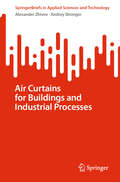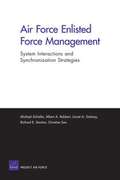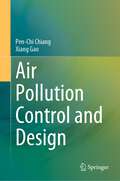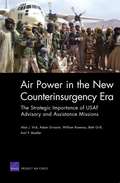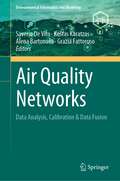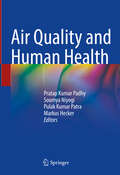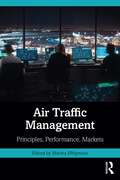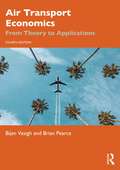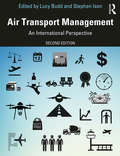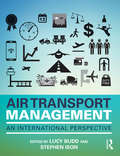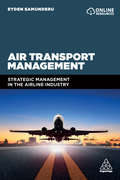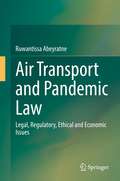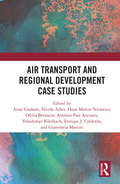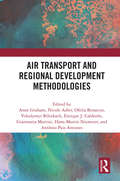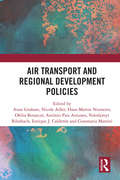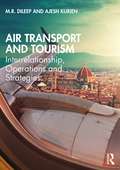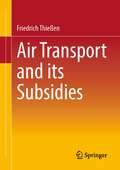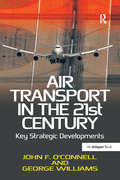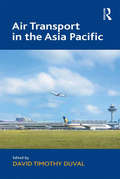- Table View
- List View
Air Curtains for Buildings and Industrial Processes (SpringerBriefs in Applied Sciences and Technology)
by Alexander Zhivov Andrey StronginThis book is based on several decades of authors’ research and practical experience in the areas of industrial and commercial buildings ventilation and energy efficiency as well as in process optimization in different types of industrial facilities. The Book discusses different types of air curtains used around the world and describes design, applications, pros and cons and examples for each type of air curtain. The book is illustrated with schematics of air curtains and pictures from their real-life implementation from around-the -world. To compare various design of air curtains, authors propose several indicators/efficiency criteria, which address effectiveness of air curtains, their energy and performance efficiency. The target audience for this book are energy and process engineers and designers of large commercial and industrial facilities, warehouses, and hangars.
Air Force Enlisted Force Management
by Albert A. Robbert Richard E. Stanton Christine San Lionel A. Galway Michael SchieferA fundamental goal of the Air Force personnel system is to ensure that the manpower inventory, by Air Force specialty code and grade, matches requirements. However, there are structural obstacles that impede achieving this goal. To remove one of those obstacles, the authors propose a methodology that would marginally modify grade authorizations within skill levels to make it possible to better achieve manpower targets.
Air Pollution Brings Down the Stock Market
by Scott Berinato Anthony HeyesHBR Interview - When researchers compared daily data from the S&P 500 index with daily environmental data from Lower Manhattan, they discovered a connection between poor air quality and diminished stock performance.
Air Pollution Control and Design
by Pen-Chi Chiang Xiang GaoThis book focuses specifically on the environmental issues related to the air pollution control and design. It is divided into four parts: (1) Fundamentals of air pollution control, (2) fundamentals of energy utilization, (3) gaseous control and design, and (4) particulate control and design, each consisting of four to six chapters. The topics covered in this book not only introduce the basic concepts of air pollution control and design but also address the fundamentals of energy utilization in the context of good engineering practice and policy instruments. It also features several innovative technologies and integrated methodologies relating to gaseous and particulate matter control and design. To facilitate technology integration and meet the need for comprehensive information on sustainable development, the book discusses a wide range of areas concerning the principles, applications, and assessment of air pollution control and design and thermodynamics, heat transfer, advanced combustion and renewable energy for energy utilization. It also features regulations and policy instruments adopted around the globe as well as several case studies. Presenting the emerging challenges, new concepts, innovative methodologies, and resolving strategies, as well as illustrative and inspiring case studies, it appeals to a wide range of readers, such as researchers, graduate students, engineers, policy makers, and entrepreneurs.
Air Power in the New Counterinsurgency Era: The Strategic Importance of USAF Advisory and Assistance Missions
by Beth Grill William Rosenau Alan J. Vick Karl P. Mueller Adam GrissomUnited States has engaged in counterinsurgency around the globe for more than a century. But insurgencies have rarely been defeated by outside powers. Rather, the afflicted nation itself must win the war politically and militarily, and the best way to help is to offer advice, training, and equipment. Air power, and the U.S. Air Force, can play an important role in such efforts, which suggests making them an institutional priority.
Air Products' Pursuit of Airgas (A)
by Paul M. Healy Penelope Rossano Charles C.Y. Wang Kyle ThomasThis case centers around the Air Products' hostile takeover attempt of Airgas in 2010. Air Products argued that its offer of a 38% premium is generous given Airgas' poor performance, which Air Products attributed to underperforming and entrenched managers at Airgas. On the other hand, Airgas' management argued that the company's recent struggles are cyclical and that Air Products' offer grossly undervalues Airgas' long-run potential. How might Airgas' management credibly communicate its conviction to shareholders? Should Airgas shareholders side with Air Products and accept a certain short term return, or should they side with Airgas' management and accept an uncertain but potentially higher long-term outcome? How should the Airgas board balance its responsibilities to short-term versus long-term shareholders?
Air Products’ Pursuit of Airgas (C)
by Paul M. Healy Charles C.Y. Wang Kyle ThomasSupplement - This case centers around the Air Products' hostile takeover attempt of Airgas in 2010. Air Products argued that its offer of a 38% premium is generous given Airgas' poor performance, which Air Products attributed to underperforming and entrenched managers at Airgas. On the other hand, Airgas' management argued that the company's recent struggles are cyclical and that Air Products' offer grossly undervalues Airgas' long-run potential. How might Airgas' management credibly communicate its conviction to shareholders? Should Airgas shareholders side with Air Products and accept a certain short term return, or should they side with Airgas' management and accept an uncertain but potentially higher long-term outcome? How should the Airgas board balance its responsibilities to short-term versus long-term shareholders?
Air Products’ Pursuit of Airgas (D)
by Paul M. Healy Charles C.Y. Wang Kyle ThomasSupplement - This case centers around the Air Products' hostile takeover attempt of Airgas in 2010. Air Products argued that its offer of a 38% premium is generous given Airgas' poor performance, which Air Products attributed to underperforming and entrenched managers at Airgas. On the other hand, Airgas' management argued that the company's recent struggles are cyclical and that Air Products' offer grossly undervalues Airgas' long-run potential. How might Airgas' management credibly communicate its conviction to shareholders? Should Airgas shareholders side with Air Products and accept a certain short term return, or should they side with Airgas' management and accept an uncertain but potentially higher long-term outcome? How should the Airgas board balance its responsibilities to short-term versus long-term shareholders?
Air Quality Networks: Data Analysis, Calibration & Data Fusion (Environmental Informatics and Modeling)
by Kostas Karatzas Saverio De Vito Alena Bartonova Grazia FattorusoThis volume offers expert contributions proposing new and recently set scientific standards for smart air quality (AQ) networks data processing, along with results obtained during field deployments of pervasive and mobile systems. The book is divided into 5 main sections; 1) future air quality networks, 2) general data processing techniques, 3) field deployments performances, 4) special applications, and 5) cooperative and regulatory efforts. The authors offer different sources of data for the production of trustworthy insights, including spatio-temporal predictive AQ maps meant to boost citizen awareness, and informed participation in remediation and prevention policies. Readers will learn about the best and most up-to-date practices for measuring and assessing air quality, while also learning about current regulatory statuses regarding air quality technology design and implementation. The book will be of interest to air quality regulatory agencies, citizen science groups, city authorities, and researchers and students working with air quality sensors and geostatistics.
Air Quality and Human Health
by Markus Hecker Pratap Kumar Padhy Soumya Niyogi Pulak Kumar PatraThe book is one of the outcomes of the SPARC (Scheme for Promotion of Academic and Research Collaboration) project titled "Fine particulates matters in the air environment and their cancer risks in human beings," sponsored by MHRD (now MoE), Govt. of India. The editors of the book are PIs and Co-PIs of the said project. The text deliberates on air pollution's health risks with contributions from well-known experts from diverse research fields (environmental science, toxicology, geology, public health science, biology, physics, chemistry, and geospatial technology). It explores it its control and mitigation strategies. The book provides an up-to-date overview of the modern methods and tools used in air quality monitoring and human health risk assessment. Case studies from different global settings offer invaluable insights into air pollution-related regional health issues. It addresses all aspects of air quality, covering indoor-outdoor air pollution, gaseous and particulate pollutants; characterization of source and pathways of air pollutants; and the modeling and assessing of health risks (respiratory, epidemiological, and toxicological) with regional and global perspectives. It also addresses air quality management issues. The lucid explanation of the role of oxidative stress mechanisms and molecular biomarkers (genomics, proteomics) may be considered as inputs into the development of cancer therapeutics. Along with providing a scientific basis for air pollution, this book will help readers appreciate the environmental determinants of public health and apply research evidence to improve the quality of life. It also delineates future research initiatives and policy actions needed to protect human health from air pollution, locally and globally. The book will be of great educational value and help for consultation and teaching.
Air Traffic Controllers
by Michael Beer Bert A. SpectorOn August 3, 1981 President Ronald Reagan terminated 12,000 air traffic controllers, members of the Professional Air Traffic Controllers Organization, for violating their no-strike oath. Provides background on the human resources policies and practices of the Federal Aviation System and information concerning the negotiations and impact of the terminations.
Air Traffic Management: Principles, Performance, Markets
by Marina EfthymiouThis book addresses each of the Air Navigation Services' five broad categories of services provided to air traffic during all phases of operation: air traffic management (ATM), communication, navigation and surveillance services (CNS), meteorological services for air navigation (MET), aeronautical information services (AIS) and search and rescue (SAR). This book is designed for working professionals in Air Transport Management, but also undergraduate and postgraduate students studying air transport management and aeronautical engineering. It will also be very helpful for the training of air traffic control officers (ATCOs). The book does not require any prior (specialist) knowledge as it is an introduction to air navigation service provider (ANSP) business. There is very little literature available that gives a detailed appreciation of the complexities, potential risks and issues associated with the provision of air navigation services. The role of this book is to fill this significant gap with a comprehensive, in-depth study of the management principles related to ANSPs. This is particularly timely given recent ATC developments in Europe, USA and New Zealand. Airlines and airports rely on the ANSPs for the management of air traffic. Hence, air navigation services (ANS) provision is considered as a core element for air transportation.
Air Transport Economics: From Theory to Applications
by Brian Pearce Bijan VasighAir Transport Economics: From Theory to Applications uniquely merges the institutional and technical aspects of the aviation industry with their theoretical economic underpinnings. Its integrative approach offers a fresh point of view that will find favor with many students of aviation. This fourth edition has undergone extensive updates throughout. It features new material addressing the impact of COVID-19 on the air transport industry, and the efforts made by both the industry and governments to facilitate recovery. A new chapter examines the impact of air transport on climate change and how government policies to address this issue could reshape the industry. Additionally, alongside expanded coverage of revenue management and pricing decisions, this fourth edition incorporates case studies that give real-world examples to reflect current industry practices. Moreover, there is a discussion of the latest computer applications that enhance the effectiveness of the new techniques. This book offers a self-contained theory and applications-oriented text for individuals aspiring to enter the aviation industry as a practicing professional in the management area. It will be of the greatest relevance to undergraduate and graduate students aiming to acquire a comprehensive grasp of the economics of the aviation industry. The review questions at the end of each chapter have been expanded considerably, and an online assignment has been introduced for each chapter. This book will also appeal to many professionals who seek an accessible and practical explanation of the underlying economic forces that shape the industry.
Air Transport Management: An International Perspective
by Lucy BuddAir Transport Management: An International Perspective provides in-depth instruction in the diverse and dynamic area of commercial air transport management. The 2nd edition has been extensively revised and updated to reflect the latest developments in the sector. The textbook includes both introductory reference material and more advanced content so as to provide a solid foundation in the core principles and practices of air transport management. This 2nd edition includes a new chapter on airline regulation and deregulation and new dedicated chapters focusing on aviation safety and aviation security. Four new contributors bring additional insights and expertise to the book. The 2nd edition retains many of the key features of the 1st edition, including: • A clearly structured topic-based approach that provides information on key air transport management issues including: aviation law, economics; airport and airline management; finance; environmental impacts, human resource management; and marketing; • Chapters authored by leading air transport academics and practitioners worldwide which provide an international perspective; • Learning objectives and key points which provide a framework for learning; • Boxed case studies and examples in each chapter; • Keyword definitions and stop and think boxes to prompt reflection and aid understanding of key terms and concepts. Designed for undergraduate and postgraduate students studying aviation and business management degree programmes and industry practitioners seeking to expand their knowledge base, the book provides a single point of reference to the key legal, regulatory, strategic and operational concepts and processes that shape the form and function of the world’s commercial air transport industry.
Air Transport Management: An international perspective
by Lucy Budd Stephen IsonCommercial air transport is a global multimillion dollar industry that underpins the world economy and facilitates the movement of over 3 billion passengers and 50 million tonnes of air freight worldwide each year. With a clearly structured topic-based approach, this textbook presents readers with the key issues in air transport management, including: aviation law and regulation, economics, finance, airport and airline management, environmental considerations, human resource management and marketing. The book comprises carefully selected contributions from leading aviation scholars and industry professionals worldwide. To help students in their studies the book includes case studies, examples, learning objectives, keyword definitions and ‘stop and think’ boxes to prompt reflection and to aid understanding. Air Transport Management provides in-depth instruction for undergraduate and postgraduate students studying aviation and business management-related degrees. It also offers support to industry practitioners seeking to expand their knowledge base.
Air Transport Management: Strategic Management in the Airline Industry
by Eyden SamunderuThe aviation industry is a major driver of world trade. As global markets and economies are constantly evolving, practitioners and academics need more quality information and a broader perspective of aviation management rather than just silo-based knowledge, particularly if they wish to move up the management ladder and progress. Air Transport Management presents the dynamic shifts which have influenced structural changes in the aviation industry, such as the emergence of low cost carriers. These changes have transformed the market, leading to deregulation and consolidation. The author provides a viable road map aimed at giving students and managers in the aviation industry a rigorous understanding on how to manage strategically in complex and turbulent market conditions. Air Transport Management examines the airline industry structure in terms of entry barriers, competition dynamics and competing business models. With the inclusion of fascinating case studies, this handbook assesses different business models used by international companies and proposes best fit management practices which airlines should follow in order to survive. Online supporting resources include PowerPoints of lesson plans.
Air Transport and Pandemic Law: Legal, Regulatory, Ethical and Economic Issues
by Ruwantissa AbeyratneThe book discusses legal, ethical, economic and trade aspects of the Pandemic as it affects air transport. It commences with the chronology of the virus spread and examines the various facets of human existential perspectives affected by the pandemic. Following this background is an evaluation of the effect on trade and economics, as well as the legal and regulatory structure concerning communicable diseases applicable to air transport. There is also a detailed discussion on legal liabilities and responsibilities of the State, airlines, airports and public both collectively and individually in coping with the pandemic against the backdrop of public health and the law. The Conclusion contains various recommendations on proactive measures that could be taken to ensure the establishment of a credible and effective legal and regulatory system to combat future pandemics.
Air Transport and Regional Development Case Studies
by Anne Graham Gianmaria Martini Hans-Martin Niemeier Nicole Adler Ofelia Betancor António Pais Antunes Volodymyr Bilotkach Enrique J. CalderónThis book is one of three inter-connected books related to a four-year European Cooperation in Science and Technology (COST) Action established in 2015. The Action, called Air Transport and Regional Development (ATARD), aimed to promote a better understanding of how the air transport related problems of core regions and remote regions should be addressed in order to enhance both economic competitiveness and social cohesion in Europe. This book focuses on case studies in Europe related to air transport and regional development. It is divided into four geographical regions after a general chapter that compares regional air transport connectivity between remote and central areas in Europe. The first region is Northern and Western Northern Europe (case studies related specifically to Norway, Finland, the United Kingdom, and Ireland); the second is Central and Eastern Europe, (Bulgaria, Bosnia and Herzegovina, and Poland); the third is Central Western Europe (Belgium and Switzerland); and finally, the fourth is Southern Europe (Portugal, Spain, and Italy). There is no other single source publication that currently covers this topic area in such a comprehensive manner by considering so many countries. The book aims at becoming a major reference on the topic, drawing from experienced researchers in the field, covering the diverse experience and knowledge of the members of the COST Action. The book will appeal to academics, practitioners, and policymakers who have a particular interest in acquiring detailed comparative knowledge and understanding of air transport and regional development in many different European countries. Together with the other two books (Air Transport and Regional Development Methodologies and Air Transport and Regional Development Policies), it fills a much-needed gap in the literature.
Air Transport and Regional Development Methodologies
by Anne Graham, Nicole Adler, Ofelia Betancor, Volodymyr Bilotkach, Enrique J. Calderón, Gianmaria Martini, Hans Martin Niemeier and António Pais AntunesAir Transport and Regional Development Methodologies is one of three interconnected books related to a four-year European Cooperation in Science and Technology (COST) Action established in 2015. The action, called Air Transport and Regional Development (ATARD), aimed to promote a better understanding of how the air transport–related problems of core regions and remote regions should be addressed to enhance both economic competitiveness and social cohesion in Europe. This book discusses key methodological approaches to assessing air transport and regional development, outlining their respective strengths and weaknesses. These include input- output analysis, cost benefit analysis, computable general equilibrium models, data envelopment analysis, stochastic frontier analysis, discrete choice models and game theory. Air Transport and Regional Development Methodologies aims at becoming a major reference source on the topic, drawing from experienced researchers in the field, covering the diverse experience and knowledge of the members of the COST Action. The book will be of interest to several large groups. First, it will serve as an authoritative and comprehensive reference for academics, researchers and consultants. Second, it will advise policy- makers and government organizations at European, national and regional levels. Third, it presents invaluable insights to transport companies such as airports and airline operators. Along with the other two books (Air Transport and Regional Development Policies and Air Transport and Regional Development Case Studies), it fills a much-needed gap in the literature.
Air Transport and Regional Development Policies
by Anne Graham; Nicole Adler; Hans-Martin Niemeier; Ofelia Betancor; António Pais Antunes; Volodymyr Bilotkach; Enrique J. Calderón; Gianmaria MartiniAir Transport and Regional Development Policies is one of three interconnected books related to a four-year European Cooperation in Science and Technology (COST) Action established in 2015. The Action, called Air Transport and Regional Development (ATARD), aimed to promote a better understanding of how the air transport–related problems of core regions and remote regions should be addressed in order to enhance both economic competitiveness and social cohesion in Europe. This book focuses on policy implications related to air transport and regional development. It begins with chapters that generally discuss important policy issues related to air transport and regional development in relation to connectivity and accessibility; dependency; airport governance and regulation; and air traffic control frameworks. This is followed by a number of chapters that consider government subsidies and state aid. The final chapters focus on other policy implications (tourism development, airport expansion, passenger taxation and noise control). Currently, no other single source publication covers this topic area in such a comprehensive manner, insofar as it considers so many policies and examples. The book aims at becoming a major reference source on the topic, drawing from experienced researchers in the field, covering the diverse experience and knowledge of the members of the COST Action. The book will appeal to academics, practitioners and government bodies who have a particular interest in acquiring detailed comparative knowledge and understanding of the policy implications of air transport and regional development. Along with the other two books (Air Transport and Regional Development Methodologies and Air Transport and Regional Development Case Studies) it fills a much-needed gap in the literature.
Air Transport and Tourism: Interrelationship, Operations and Strategies
by M.R. Dileep Ajesh KurienAir Transport and Tourism: Interrelationship, Operations and Strategies is a comprehensive textbook covering all major aspects of air transport from operational and managerial perspectives, as well as exploring the intricate relationship that exists between the air transport and tourism industries. The book introduces and provides in-depth coverage of the complexities of the airline industry and the tourism industry and the ways in which they are connected and impact on each other, for example, the destination–airport–airline nexus, and the roles of air transport and airlines in tourism and vice versa. Emphasis is placed on current and future trends, the impact of COVID-19, sustainability and environmental challenges throughout. Comprehensive coverage of airline operations, strategic management and planning, airport operations and air transport information technology is also provided, offering a practical viewpoint on these vital aspects of the subject. This will be the ideal introductory textbook for students of tourism and hospitality studying courses in aviation and air travel.
Air Transport and its Subsidies
by Friedrich ThießenThe book deals with the subsidies of air transport. It shows which subsidies are used to promote air transport and how the subsidies influence the various segments of air transport. The types of subsidies dealt with correspond to the OECD's delimitation. In addition to tax breaks and transfers, capital subsidies, infrastructure subsidies, regulatory deficits and non-internalised externalities are also included. The areas of air transport in which subsidies are identified are airports, airlines and air traffic control. Furthermore, aircraft manufacturers and research as well as air transport regulation, the behaviour of MPs and airport-related infrastructure are dealt with. The subject is of general and long-term interest. The book is the most comprehensive and systematic compilation of subsidies available. The result is that air transport is permeated by a largely uncoordinated system of subsidies in all its areas, the overall effects of which have not been recorded until today.
Air Transport in the 21st Century: Key Strategic Developments
by George Williams John F. O'ConnellAirlines are buffeted by fluctuating political and economic landscapes, ever-changing competition, technology developments, globalization, increasing deregulation and evolving customer requirements. As a consequence all sectors of the air transport industry are in a constant state of flux. The principle aim of this book is to review current trends in the airline industry and its related suppliers, thereby providing an insight into the forces that are changing its dynamics. The factors that are reshaping the structure of the industry are examined with a view to identifying the key issues whose impact will be critical in the future. The book features two very distinct sections. The first contains short contributions from industry executives at CEO/VP level from airlines, aircraft/engine manufacturers, safety and navigational provider organisations, who have set out their take of where the airline industry is heading. This commercial input sets the scene for the book and provides the bridge to the second section, which is composed of 18 chapters written by distinguished academic authors. Each chapter presents a valuable insight into a specific area of the air transport industry, including: airlines, airports, cargo, deregulation, the environment, navigation, strategy, information technology, security and tourism. The shared objective of the authors is to describe and explain the core competencies that are determining the current shape of the industry and to examine the forces that will change its direction going forward. The book is written in a management style and will appeal to all levels of personnel who work for airlines across the world. It is also written for airport authorities, aerospace manufacturers, regulatory and government transportation agencies, researchers and students of aviation management, transport studies, tourism and the wider air transport industry.
Air Transport in the Asia Pacific
by David Timothy DuvalAir transport in the Asia Pacific has undergone significant transformation in the last three decades. What was once a region in the shadow of larger and more prosperous continents such as North America and Europe is now at the forefront of expansion in commercial air-service networks, frequency and capacity, and the overall growth in the contribution of air transport to economies on regional and, in many cases, individual country levels. Despite this, it represents an area that is generally under-represented in the commercial air-transport academic literature. Air Transport in the Asia Pacific seeks to fill this gap. Against this context, the aim of the volume is to offer a contemporary snapshot of current academic research into commercial air transport in the Asia Pacific. While one volume cannot realistically address the complete range of identifiable issues, this book provides timely, specific and research-based studies authored by leading academics and practitioners.
